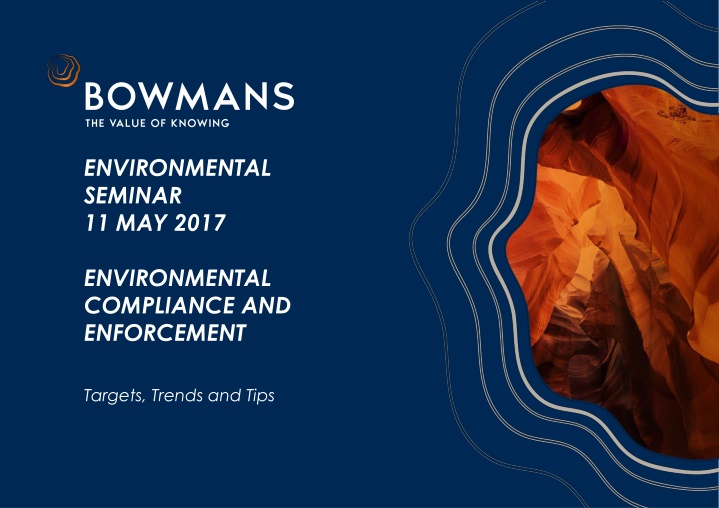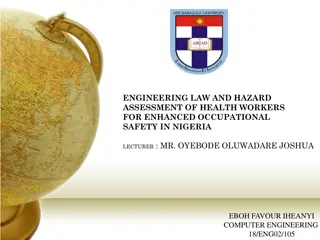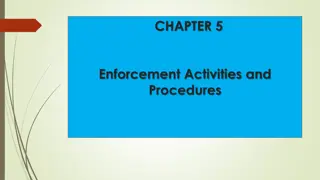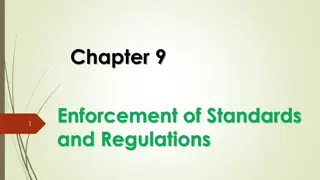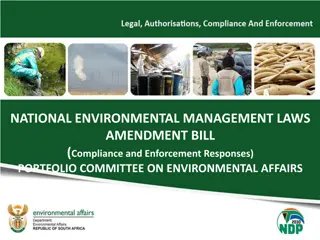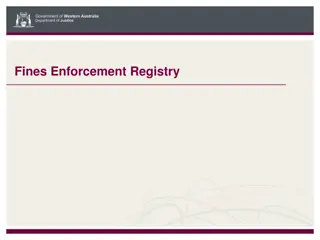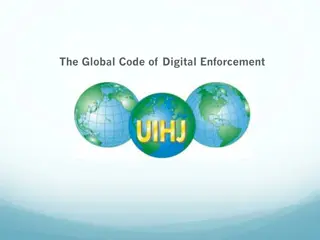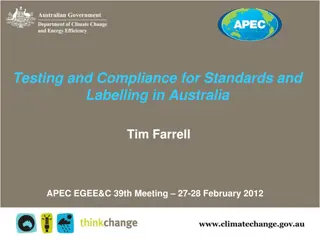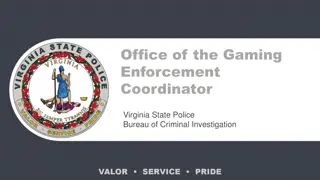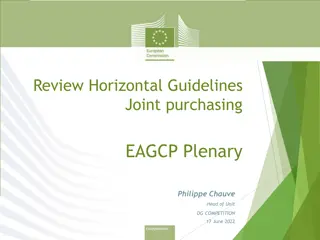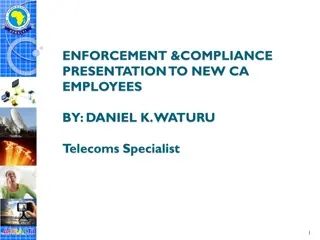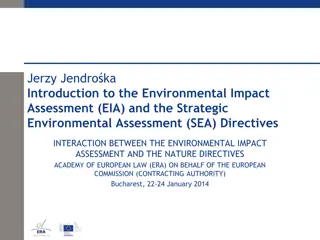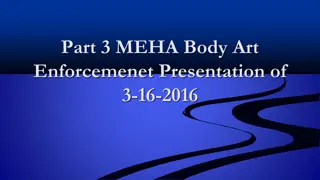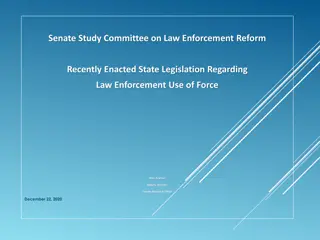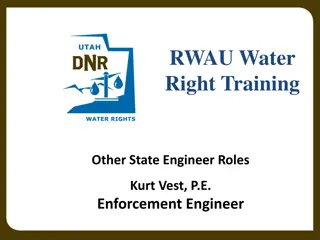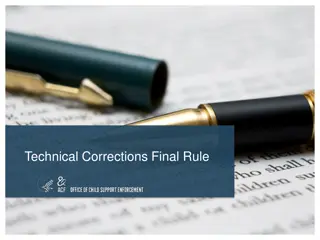Environmental Compliance and Enforcement Seminar Overview
Overview of key issues and risks discussed in an environmental compliance and enforcement seminar, highlighting the importance of compliance, potential future focus areas for authorities and the private sector, and tips for managing environmental risks proactively to avoid legal consequences.
Download Presentation

Please find below an Image/Link to download the presentation.
The content on the website is provided AS IS for your information and personal use only. It may not be sold, licensed, or shared on other websites without obtaining consent from the author.If you encounter any issues during the download, it is possible that the publisher has removed the file from their server.
You are allowed to download the files provided on this website for personal or commercial use, subject to the condition that they are used lawfully. All files are the property of their respective owners.
The content on the website is provided AS IS for your information and personal use only. It may not be sold, licensed, or shared on other websites without obtaining consent from the author.
E N D
Presentation Transcript
ENVIRONMENTAL SEMINAR 11 MAY 2017 ENVIRONMENTAL COMPLIANCE AND ENFORCEMENT Targets, Trends and Tips
MANAGING ENVIRONMENTAL RISK AT A CORPORATE AND DAY-TO- DAY LEVEL: WHAT TO DO TO AVOID ENVIRONMENTAL CRIMES AND HOW TO REACT IF ACCUSED OR RAIDED Michael Vermaak Partner, Bowmans
OVERVIEW: SUMMARY OF KEY ISSUES Go back to basics when faced with enforcement action High number of administrative actions versus low number of prosecutions Trend of increasing private sector involvement is likely to continue Possible future focus issues to be targeted by authorities: ? air emission minimum standard exceedances re. pre-2010 existing plants ? water related offences e.g. unlawful abstraction, impacts on wetlands and water resources, water pollution related offences ? pollution and waste related offences and legal limits of the responsibility regarding third party disposal practices Possible future focus issues to be targeted by private sector: ? policy level determinations on infrastructure, coal, nuclear (and other?) projects ? waste (and other?) facilities operating in proximity to residential areas and communities ? testing the implementation of the fragmented one environmental system transitional provisions ? private prosecutions in terms of section 33 of NEMA Page 3
OVERVIEW: MANAGING THE RISKS Environmental enforcement can be a major risk for business, directors and employees Attitude should be that environmental compliance is non-negotiable Aside from fines and potential imprisonment on conviction long term adverse implications to a business due to fit and proper person licensing criteria (atmospheric emission and waste management licences) Be sensitive to the precedents and developing trends in environmental judgments i.e. pro-transparency / access to environmental information and pro-environmental rights of private parties Compliance risks can manifest from administrative oversights (e.g. failing to register on information systems) or even housekeeping level related non-compliance Over criminalisation "Who breaks a butterfly upon a wheel? (Alexander Pope): almost every environmental crime at a national level has now been included as a NEMA Schedule 3 offence all the adverse consequences of section 34 of NEMA apply - potential director and employee personal criminal liability Enforcement action invariably comes as a surprise to senior management how do you avoid being surprised? Page 4
OVERVIEW: MANAGING THE RISKS Potential consequences and risks associated with non-compliance are not taken lightly by most companies, their directors, shareholders or lenders But compliance can be challenging to maintain and can be influenced by external factors: frequent changes to the environmental legislation creating uncertainty (exacerbated by inadequate attention being given to transitional provisions) legal provisions which are not drafted clearly penal provisions must be restrictively interpreted ( If there is any uncertainty about the ambit of a penalty provision, it must be resolved in favour of liberty ) incorrect application of certain legislation to activities by the authorities, such as a purported retrospective application of laws to activities that did not necessarily require authorisation at a particular historical point in time impracticality of complying with aspirational licence conditions (operation must either operate unlawfully, appeal and possibly take the decision on review or shut down to avoid operating unlawfully) Mining/industrial operations unlikely to be 100% compliant at a particular point in time? Page 5
OVERVIEW: MANAGING THE RISKS What to do to avoid inadvertent non-compliance: ensure that you are continuously actively working on maintaining compliance EMS tools like legal registers and audits, coupled with ongoing compliance advice internal and statutory audits (environmental authorisation and EMPr audits are compulsory and must be placed in the public domain per 2014 EIA Regulations) be careful of audits giving false comfort on compliance (e.g. findings of a high percentage of partial compliance i.e. there is still non-compliance that needs to be addressed) review and test the audit findings, challenge the auditors on legal interpretation where necessary and have reports amended or qualified before any harm is done escalate material findings to appropriately senior management pro-active management of licence condition compliance i.e. monitor and amend conditions to remain current and appropriate to the business, activities and practices take immediate steps to negotiate (and where necessary to challenge) conditions imposed in licences where compliance is impractical / cannot reasonably be achieved keep records of authority interaction Page 6
OVERVIEW: MANAGING THE RISKS Limiting the risks of private sector initiated enforcement: understand the risks of the sector in which you operate e.g. what developing or contentious sectoral or policy level environmental issues are there? understand the locational risks of your operations e.g. proximity to residential areas, expansion of residential areas, and resulting potential impacts use the EIA / licensing public participation processes as a risk mitigation tool to gauge the risks of proceeding with a new development or expansion: is there the capacity to make all interested and affected parties happy? what is the financial cost of doing so versus the risk of not doing so e.g. installing additional air pollution abatement infrastructure at substantial cost versus taking the risk of challenges versus changing the development site location? can the operational stage risks be reasonably mitigated or are there going to be persistent challenges throughout the life of the operation? Page 7
OVERVIEW: MANAGING THE RISKS What if you are targeted for enforcement: most administrative actions (directives and compliance notices) don t ultimately result in a prosecution handling of the risks is important get specialist legal advice from an environmental attorney without delay determine if there is a basis for a defence to limit the prospects of prosecution act fast sometimes lengthy time periods required to gather information and evidence for making representations regarding the alleged non-compliance prepare for an environmental management inspector (EMI) inspection: know what to expect know what your rights are know what the EMI s rights are usually are opportunities to comment on the pre-compliance steps use them correctly and ensure all relevant aspects of the allegations are considered and adequately addressed Page 8
QUESTIONS Are there any questions? Page 9
BOWMANS OFFICE CONTACTS Cape Town T: +27 21 480 7800 E: info-cpt@bowmanslaw.com Johannesburg T: +27 11 669 9000 E: info-jhb@bowmanslaw.com Dar es Salaam T: +255 22 219 8000 E: info-tz@bowmanslaw.com Kampala T: +256 41 425 4540 E: info-ug@bowmanslaw.com Durban T: +27 31 265 0651 E: info-dbn@bowmanslaw.com Nairobi T: +254 20 289 9000 E: info-ke@bowmanslaw.com Follow us on @Bowmans_Law Bowmans Bowmans www.bowmanslaw.com Page 10
